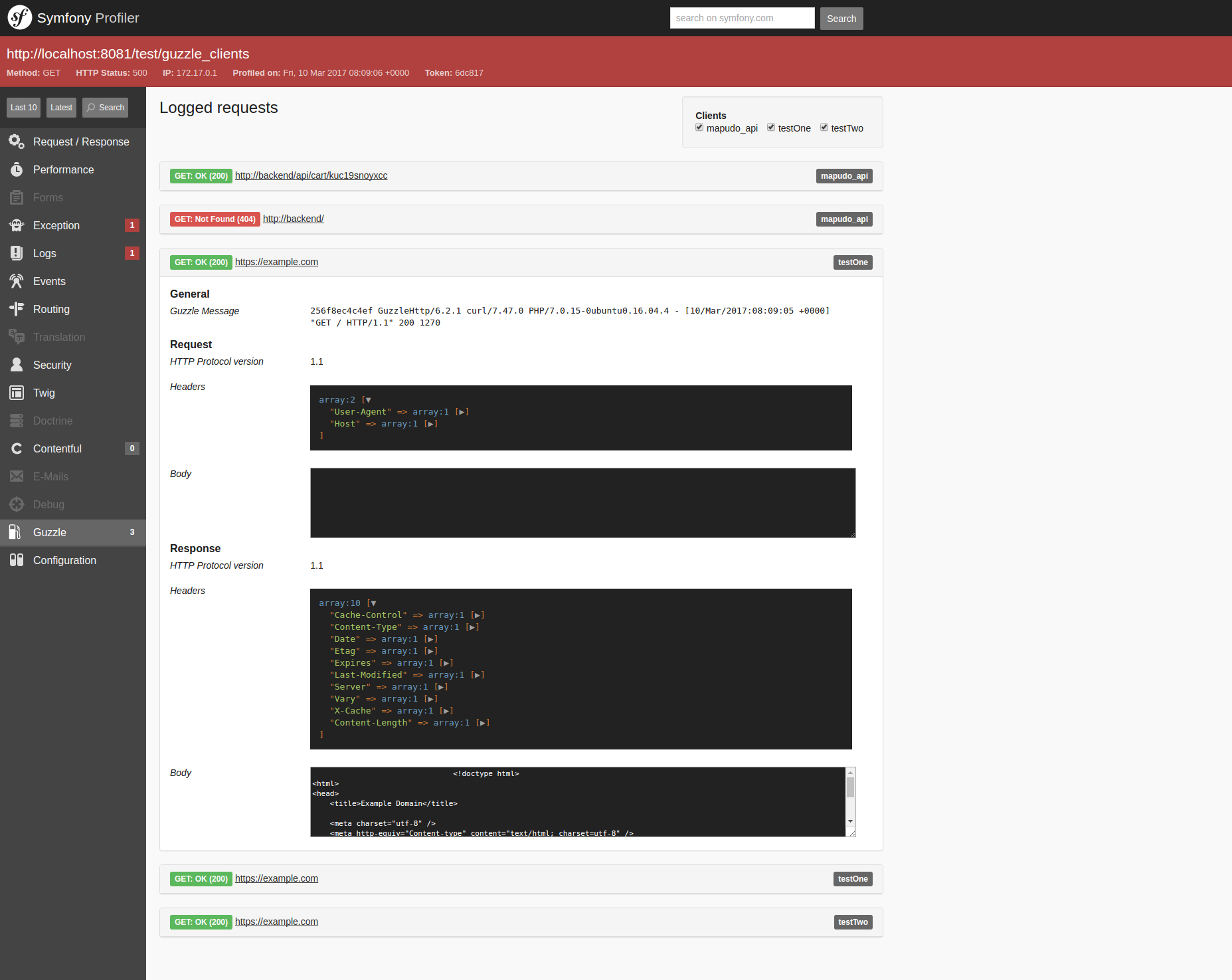mapudo / guzzle-bundle
Mapudo GuzzleBundle 允许将 Guzzle 集成到 Symfony 项目中
Requires
- php: ^7.0
- guzzlehttp/guzzle: ~6.0
- psr/log: ~1.0
- symfony/dependency-injection: ~2.8|~3.0|~4.0
- symfony/event-dispatcher: ~2.8|~3.0|~4.0
- symfony/expression-language: ~2.8|~3.0|~4.0
- symfony/http-kernel: ~2.8|~3.0|~4.0
- symfony/monolog-bundle: ~2.8|~3.0|~4.0
- symfony/property-access: ~2.8|~3.0|~4.0
- symfony/serializer: ~2.8|~3.0|~4.0
Requires (Dev)
- phpunit/phpunit: ~5.5
- symfony/config: 2.3|~3.0|~4.0
This package is auto-updated.
Last update: 2024-09-22 20:33:07 UTC
README
要求 | 安装 | 使用 | 贡献 | 安全 | 许可 | 关于
GuzzleBundle
Mapudo GuzzleBundle 允许将 Guzzle 集成到 Symfony 项目中。
此包的主要特性包括
- 轻松添加自定义中间件和事件监听器
- 接近 100% 的测试覆盖率
- 从底层开始为 PHP 7 编写
- 内置中间件
- 通过 Monolog 在单独的
guzzle通道上进行日志记录 - 通过 Symfony Profiler (使用 Bootstrap 风格化) 和 DebugBar 进行请求调试
- 通过 Symfony 事件框架进行事件分发
- 通过 Monolog 在单独的
为什么还需要另一个 Guzzle Bundle?我们只是对现有包的代码质量和中间件集成不满意,而且他们的维护者没有解决我们的问题。
要求
- PHP 7.0 及更高版本
- Symfony ~2.8|~3.0|~4.0
安装
通过 Composer
$ composer require mapudo/guzzle-bundle
使用
激活包
在您的 AppKernel.php 中注册包。
// app/AppKernel.php ... new Mapudo\Bundle\GuzzleBundle\GuzzleBundle(), ...
配置
通过 app/config.yml 配置包。您可以为多个客户端定义基本选项。
guzzle: clients: test_client: base_uri: 'https://example.com/path' headers: Accept: 'application/json' Accept-Language: 'de' request_options: allow_redirects: true cert: - '/path/to/cert.pem' - 'password' another_client: base_uri: 'https://another.example.com/root/child' headers: X-Auth: 'token'
所有在 Guzzle 文档 中文档化的 request_options 都可以配置给客户端,但以下选项只能为单个请求设置
bodycookiesdebugform_paramsjsonmultiparton_headerson_statsprogresssink
配置中定义的客户端随后将由包的 CompilerPass 注册,然后您可以通过名称从容器中访问它们。对于上述情况,我们将有两个客户端,我们可以使用 guzzle.client.test_client 和 guzzle.client.another_client 访问它们。
发出请求
发出请求很容易,本质上与直接使用 Guzzle 相同。如上所述,您也可以在此处设置通过配置不可用的 request_options。
<?php $client = $container->get('guzzle.client.test_client'); $moreOptions = ['on_stats' => function (\GuzzleHttp\TransferStats $stats) { echo $stats->getEffectiveUri() . "\n"; echo $stats->getTransferTime() . "\n"; }]; $client->requestAsync(\Symfony\Component\HttpFoundation\Request::METHOD_GET, '/path/without/base_uri', $moreOptions);
注意: 在添加新的日志处理器或中间件后,请清除缓存,以便再次运行 CompilerPass。
日志记录
CompilerPass 注册了一个日志中间件,它定义了一个 guzzle 日志通道。默认情况下,所有在您的配置中定义的 Monolog 处理程序都将记录这些请求。要禁用特定处理程序的日志记录,请将 !guzzle 添加到处理程序的通道列表中。
monolog: handlers: main: channels: [!guzzle]
还可以将请求数据记录到 Symfony Profiler 和调试工具栏中。要执行此操作,请使用以下配置激活内置的 profiler 处理程序
monolog: handlers: my_debug_handler: type: service id: mapudo_bundle_guzzle.log_handler.symfony_profiler_handler level: debug channels: [guzzle] ## add additional handlers as needed # my_other_handler: # ... # channels: [guzzle]
添加此处理程序后,您需要重新构建资产,以便您的Profiler能够以正确样式显示,例如使用assets:install。在这里,您可以选择显示哪个客户端的请求。
登录特定通道
默认情况下,LogMiddleware将日志记录到“guzzle”通道。如果您想使用不同的处理程序(取决于通道),您可以为此定义一个服务标签。
YAML
mapudo_frontend.mapudo_api.log_middleware: class: Mapudo\Bundle\GuzzleBundle\Middleware\LogMiddleware tags: - { name: guzzle.middleware, method: log, client: mapudo_api, channel: timings }
如你所见,现在标签包含一个“channel”节点。如果配置如此,guzzle客户端mapudo_api将注入使用/多个日志记录到计时通道的LogMiddleware作为中间件。
重要
请注意,LogMiddleware的服务ID必须包含名称
log_middleware,因为编译器传递会检查服务定义是否包含此名称以检索通道。
添加自己的日志记录
此包使用Symfony的规范化器在将请求和响应对象传递给日志记录器之前规范化它们。这允许您将请求和响应作为数组处理。如果您想用对象来处理,该包提供请求和响应规范化器,它将数组转换为相应的对象。
例如,要编写自己的处理程序,请从给定上下文中取出响应和请求数组,并对其进行规范化。
<?php if ($record['context']) { $response = null; if (!empty($record['context']['response'])) { $response = $this->responseDenormalizer->denormalize($record['context']['response'], Response::class); } if (!empty($record['context']['request'])) { /** @var Request $request */ $request = $this->requestDenormalizer->denormalize($record['context']['request'], Request::class); $request->setResponse($response); } }
或者只做你想做的。
中间件
此包已经实现了两个中间件服务。一个是派发事件,另一个是使用给定处理程序的日志记录。
添加自己的中间件
该包支持使用__invoke()或创建自定义method来注册中间件。
编译器传递会搜索带有guzzle.middleware标签的服务。标签method是可选的,用于定义如果没有在中间件中使用__invoke(),则应执行哪个方法。您需要添加带有客户端名称的client标签。然而,如果您想为所有客户端创建中间件,则可以省略此标签。
YAML
services: guzzle.middleware.my_middleware: class: exampleClass tags: - { name: guzzle.middleware, method: addMyMiddleware, client: test_client }
XML
<services> <service id="guzzle.middleware.my_middleware" class="exampleClass"> <tag name="guzzle.middleware" method="addMyMiddleware" client="test_client"/> </service> </services>
事件
添加自己的事件监听器
编译器传递会搜索带有kernel.event_listener标签的服务。标签event也是必需的,用于定义要监听哪个事件。您可以使用guzzle_event.pre_transaction或guzzle_event.post_transaction。与中间件不同,这里需要一个客户端名称。
YAML
services: guzzle.event.my_event: class: exampleClass tags: - { name: kernel.event_listener, event: guzzle_event.pre_transaction, client: test_client }
XML
<services> <service id="guzzle.event.my_event" class="exampleClass"> <tag name="kernel.event_listener" event="guzzle_event.pre_transaction" client="test_client"/> </service> </services>
贡献
有关详细信息,请参阅CONTRIBUTING。
安全
如果您发现任何安全相关的问题,请通过电子邮件mailto:security@mapudo.com而不是使用问题跟踪器。
许可
MIT许可(MIT)。有关更多信息,请参阅许可文件。
关于
此包由Mapudo编写,Mapudo是在线物料市场。 我们在招聘!
